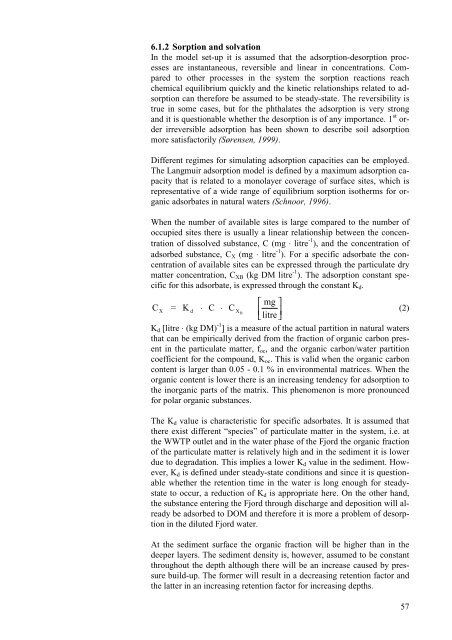Phthalates and Nonylphenols in Roskilde Fjord
Phthalates and Nonylphenols in Roskilde Fjord
Phthalates and Nonylphenols in Roskilde Fjord
Create successful ePaper yourself
Turn your PDF publications into a flip-book with our unique Google optimized e-Paper software.
6.1.2 Sorption <strong>and</strong> solvationIn the model set-up it is assumed that the adsorption-desorption processesare <strong>in</strong>stantaneous, reversible <strong>and</strong> l<strong>in</strong>ear <strong>in</strong> concentrations. Comparedto other processes <strong>in</strong> the system the sorption reactions reachchemical equilibrium quickly <strong>and</strong> the k<strong>in</strong>etic relationships related to adsorptioncan therefore be assumed to be steady-state. The reversibility istrue <strong>in</strong> some cases, but for the phthalates the adsorption is very strong<strong>and</strong> it is questionable whether the desorption is of any importance. 1 st orderirreversible adsorption has been shown to describe soil adsorptionmore satisfactorily (Sørensen, 1999).Different regimes for simulat<strong>in</strong>g adsorption capacities can be employed.The Langmuir adsorption model is def<strong>in</strong>ed by a maximum adsorption capacitythat is related to a monolayer coverage of surface sites, which isrepresentative of a wide range of equilibrium sorption isotherms for organicadsorbates <strong>in</strong> natural waters (Schnoor, 1996).When the number of available sites is large compared to the number ofoccupied sites there is usually a l<strong>in</strong>ear relationship between the concentrationof dissolved substance, C (mg ⋅ litre -1 ), <strong>and</strong> the concentration ofadsorbed substance, C X (mg ⋅ litre -1 ). For a specific adsorbate the concentrationof available sites can be expressed through the particulate drymatter concentration, C XB (kg DM litre -1 ). The adsorption constant specificfor this adsorbate, is expressed through the constant K d .⎡ mg ⎤CX= Kd ⋅ C ⋅ CX B ⎢ ⎥(2)⎣litre⎦K d [litre ⋅ (kg DM) -1 ] is a measure of the actual partition <strong>in</strong> natural watersthat can be empirically derived from the fraction of organic carbon present<strong>in</strong> the particulate matter, f oc , <strong>and</strong> the organic carbon/water partitioncoefficient for the compound, K oc . This is valid when the organic carboncontent is larger than 0.05 - 0.1 % <strong>in</strong> environmental matrices. When theorganic content is lower there is an <strong>in</strong>creas<strong>in</strong>g tendency for adsorption tothe <strong>in</strong>organic parts of the matrix. This phenomenon is more pronouncedfor polar organic substances.The K d value is characteristic for specific adsorbates. It is assumed thatthere exist different “species” of particulate matter <strong>in</strong> the system, i.e. atthe WWTP outlet <strong>and</strong> <strong>in</strong> the water phase of the <strong>Fjord</strong> the organic fractionof the particulate matter is relatively high <strong>and</strong> <strong>in</strong> the sediment it is lowerdue to degradation. This implies a lower K d value <strong>in</strong> the sediment. However,K d is def<strong>in</strong>ed under steady-state conditions <strong>and</strong> s<strong>in</strong>ce it is questionablewhether the retention time <strong>in</strong> the water is long enough for steadystateto occur, a reduction of K d is appropriate here. On the other h<strong>and</strong>,the substance enter<strong>in</strong>g the <strong>Fjord</strong> through discharge <strong>and</strong> deposition will alreadybe adsorbed to DOM <strong>and</strong> therefore it is more a problem of desorption<strong>in</strong> the diluted <strong>Fjord</strong> water.At the sediment surface the organic fraction will be higher than <strong>in</strong> thedeeper layers. The sediment density is, however, assumed to be constantthroughout the depth although there will be an <strong>in</strong>crease caused by pressurebuild-up. The former will result <strong>in</strong> a decreas<strong>in</strong>g retention factor <strong>and</strong>the latter <strong>in</strong> an <strong>in</strong>creas<strong>in</strong>g retention factor for <strong>in</strong>creas<strong>in</strong>g depths.57
















